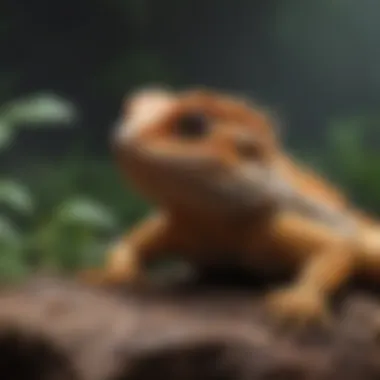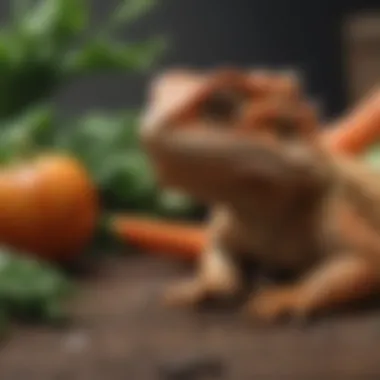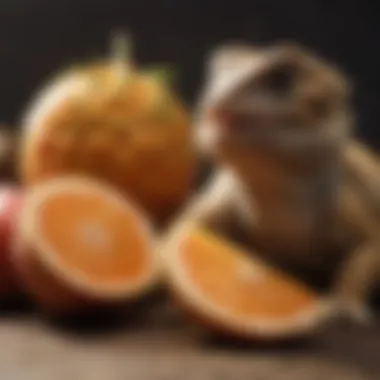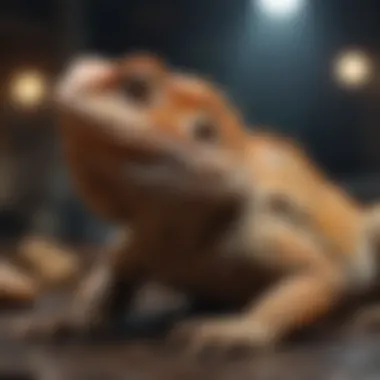Essential Food Guide for Bearded Dragons: What to Feed


Intro
Understanding the diet of a bearded dragon is crucial for ensuring their long-term health and well-being. Many owners may not realize the specific nutritional requirements these reptiles have, which can lead to both health issues and improper care. This section will highlight key points on suitable foods, focusing on variety and nutritional balance.
Many people incorrectly assume that bearded dragons can eat anything they find in their habitats. This misconception can result in feeding unsafe or toxic items. It is essential to be informed about what foods are nutritionally beneficial and what should be completely avoided.
As we delve into the specifics of the dietary needs for bearded dragons, we will cover various food categories. These include insects, vegetables, and fruits. We will also address the importance of feeding frequency and offer practical tips for owners. Thus, this exploration will help foster a deeper understanding of proper feeding practices for bearded dragons.
Pet Care and Grooming
Importance of Regular Care
Regular care is essential for bearded dragons. A proper diet contributes significantly to their overall health. This in turn can prevent many health issues accustomed with improper nutrition. Routine checks on their diet are neccessary to ensure they are getting the right balance of proteins, vitamins, and minerals.
Grooming Techniques by Pet Type
Grooming a bearded dragon is different from grooming pets like dogs or cats. While they do not need extensive grooming, ensuring their habitat is clean is important. Regular cleaning of their terrarium helps prevent diseases. Additionally, washing vegetables before feeding is good practice as it removes harmful pesticides.
Tools and Products Recommendations
For maintaining their habitat, consider these tools:
- A high-quality terrarium cleaner
- A reliable dish for food and water
- Appropriate substrate for easy cleaning
These products help create an environment that is both safe and comfortable for your dragon.
Seasonal Care Tips
Seasons may affect a bearded dragon's behavior and health. In winter, they may need additional heat sources due to cooler temperatures. Conversely, hot summers may necessitate better hydration and cooling methods. Always be alert to how your pet reacts to changes in their environment.
Health and Nutrition
Understanding Pet Nutrition
Nutrition is paramount when it comes to bearded dragons. They require a diverse diet that incorporates different food groups. Insects serve as a primary protein source, while vegetables provide necessary vitamins and fiber. Fruits can be offered in moderation as treats.
Common Health Issues by Species
Bearded dragons often face health problems if their diet is lacking. Metabolic Bone Disease, obesity, and gastrointestinal issues can all arise from improper dietary habits. Regular veterinary check-ups can help to identify and treat these concerns early on.
Preventive Care and Regular Check-Ups
Regular check-ups with a veterinarian who understands reptile care are vital. They can provide tailored dietary advice and monitor your dragon's weight. This ensures your pet remains happy and healthy.
Food and Dietary Advice
Focus on providing variety in the diet to prevent nutritional deficiencies. Insects like crickets and mealworms provide protein, while leafy greens like collard greens and kale offer essential vitamins. Avoid feeding iceberg lettuce as it offers little nutritional value.
Epilogue
Understanding the Diet of Bearded Dragons
Understanding the diet of bearded dragons is essential for their health and well-being. Proper nutrition impacts their growth, activity levels, and overall quality of life. This section will delve into the core components of a bearded dragon's diet, highlighting the significance of choosing appropriate foods and ensuring a balanced intake.
Importance of Proper Nutrition
Proper nutrition is crucial for bearded dragons. A balanced diet supports their immune system, helps in metabolism, and promotes healthy growth throughout their lifecycle. Insufficient or improper feeding can result in health issues such as obesity, metabolic bone disease, or organ dysfunction. It is essential for pet owners to be informed about the dietary requirements of these reptiles.
Additionally, monitoring the nutritional content of food can lead to better feeding practices. Calcium, phosphorus, and vitamins play a significant role in maintaining health. Understanding these elements helps prevent common nutritional deficiencies, making proper nutrition fundamental.
Natural Habitat and Food Sources
Bearded dragons originate from arid regions in Australia. Their natural habitat influences their dietary choices and preferences. In the wild, they predominantly consume a varied diet composed of insects, plants, and fruits. They are classified as omnivores, which means they thrive on both animal protein and plant matter.
Common food sources in the wild include:
- Insects: crickets, grasshoppers, and beetles
- Vegetation: leaves, flowers, and fruits
Recognizing these natural food sources informs the choices pet owners make when selecting appropriate foods. Providing a mix of insects and vegetables simulates their wild diet and offers essential nutrients. This brings about a more satisfying feeding experience for the bearded dragon, enhancing their overall health and vitality.


Types of Foods for Bearded Dragons
Understanding the types of foods suitable for bearded dragons is essential for their overall health and wellbeing. A balanced diet that includes various foods helps ensure they receive the necessary nutrients for growth, energy, and disease resistance. Proper nutrition not only maintains their physical health but also promotes a robust immune system. This section will delve into three main food categories: insects, vegetables, and fruits. Each category plays a unique role in providing essential vitamins, minerals, and proteins.
Insects
Common Insects: Crickets and Dubia Roaches
Crickets and Dubia roaches are the most common insects in the diet of bearded dragons. They provide high protein, aiding in muscle development and energy levels. Crickets are readily available in pet stores and are inexpensive, making them a popular choice among bearded dragon owners. Dubia roaches, while slightly more costly, offer a more nutrient-dense option. This makes them especially beneficial for juvenile dragons that need more protein for growth.
Advantages: Crickets and Dubia roaches are easy to digest and can be gut-loaded before feeding, enriching their nutritional content. Their high protein levels contribute significantly to the health of your bearded draggon.
Disadvantages: Crickets can jump out of their enclosure, making them less convenient. Dubia roaches require a bit more care in breeding and storage.
Feeding Frequency and Quantity
Feeding frequency and quantity are critical components regarding the dietary needs of bearded dragons. Juveniles may require feeding every day, while adults typically eat every other day. This difference is important for their health as overfeeding can lead to obesity and related diseases. Bearded dragons should be fed according to their age and size.
Advantages: It is essential to develop a consistent feeding schedule that accommodates the specific needs of your dragon. This helps ensure that they receive adequate nutrition without the risk of overfeeding.
Disadvantages: Some owners may struggle with understanding how much to feed, leading to underfeeding or overfeeding, both of which can impact health negatively.
Supplements for Insectivorous Diet
Supplements for an insectivorous diet can play a vital role in ensuring that your bearded dragon receives all the necessary vitamins and minerals. Calcium and vitamin D3 are particularly important. Since insects lack these nutrients when not gut-loaded, providing supplements can mitigate deficiencies.
Advantages: Regular supplementation can help prevent metabolic bone disease, a common ailment in captive reptiles.
Disadvantages: Over-supplementation can lead to toxicity. It's essential to follow guidelines from reputable sources when choosing products.
Vegetables
Leafy Greens: Kale, Collard Greens, and More
Leafy greens, like kale and collard greens, are an important part of the diet. These vegetables provide essential vitamins such as A, C, and K, and help maintain hydration and digestive health. They are also low in calories, making them a good choice for adult dragons to maintain a healthy weight.
Advantages: The fiber content in leafy greens aids digestion. They are also versatile, allowing for various feeding preparations.
Disadvantages: Some bearded dragons may be picky and refuse to eat certain greens. It is important to try different types to find what your pet prefers.
Root Vegetables: Carrots and Sweet Potatoes
Root vegetables, including carrots and sweet potatoes, are excellent sources of beta-carotene. This nutrient converts to vitamin A, essential for eye health and immune function in bearded dragons. Feeding root vegetables can also add variety to their diet and encourage natural foraging behavior.
Advantages: Easy to prepare and appealing to many dragons. They can be served raw or cooked, allowing for a range of textures and flavors.
Disadvantages: High in carbohydrates, so these should not be the primary vegetable source in their diet.
Importance of Variety and Nutritional Balance
The importance of variety and nutritional balance cannot be overstated. A diet too focused on one type of food can lead to nutritional deficiencies. Each food category offers specific nutrients, which collectively support better health. By rotating food options, owners can ensure their bearded dragons enjoy a more balanced diet.
Advantages: A diverse diet secures a range of minerals and vitamins for your dragon's optimal health.
Disadvantages: It may take time and experimentation to determine the proper variety for healthy eating habits in your pet.
Fruits
Recommended Fruits: Berries and Melons
Fruits such as berries and melons are refreshing treats for bearded dragons. They provide hydration and are rich in antioxidants. While fruits should only make up a small part of their diet, offering them can stimulate your dragon’s interest in food. The natural sugars found in fruits are easy for dragons to digest.
Advantages: Fruits can help improve hydration, making them a good choice in warm weather. They offer a tasty way to add nutrients without overloading the diet.
Disadvantages: Too much fruit can lead to diarrhea due to high sugar content. Moderation is essential when incorporating fruits.
Fruits to Avoid
Certain fruits are harmful to bearded dragons and should be avoided, which includes avocados and citrus fruits. These can cause digestive issues and other health complications. Knowing which fruits are toxic is crucial for responsible pet care.


Advantages: Avoiding certain fruits prevents potential health risks, ensuring your pet remains safe and healthy.
Disadvantages: Lack of awareness regarding harmful fruits can inadvertently lead to illness.
Serving Size and Presentation
Serving size and presentation are important when feeding your bearded dragon. Smaller pieces are ideal since dragons may struggle with larger bites. Also, varying the presentation can make meals more appealing. Mixing colors and shapes can help stimulate your dragon's curiosity, encouraging them to explore different types of food.
Advantages: Properly sized pieces reduce choking risks. An appealing presentation can stimulate appetite and encourage healthy eating habits.
Disadvantages: It may require extra time and effort to prepare the meals properly.
Nutritional Requirements
Understanding the nutritional requirements of bearded dragons is crucial for their health and longevity. A well-balanced diet contributes to proper growth, vitality, and the prevention of various health issues. These reptiles have specific needs for proteins, vitamins, and minerals that must be met through a suitable diet. Also, it is vital to realize that a lack of proper nutrition can lead to serious deficiencies.
Protein Needs
Proteins play a central role in the diet of bearded dragons, especially during their growth stages. Young bearded dragons require higher protein levels to support rapid development. In contrast, adult dragons need proteins for maintenance and overall health.
The primary sources of protein come from insects. Options such as crickets and dubia roaches provide vital amino acids essential for growth and tissue repair. It is important to offer a mix of insects to avoid potential nutrient gaps.
Benefits of Adequate Protein Intake:
- Supports muscle development
- Aids in tissue repair
- Promotes a healthy immune system
Finding the right balance of protein is key. Too much protein can lead to health issues. It's vital to observe your bearded dragon's condition and adjust accordingly.
Vitamins and Minerals
Vitamins and minerals are also critical dietary components. They help in various bodily functions, from metabolic processes to maintaining bone health. Calcium and vitamin D3 are particularly important. A deficiency in calcium can lead to metabolic bone disease, a critical condition in bearded dragons.
Common Deficiencies in Bearded Dragons
Many bearded dragon owners fail to recognize signs of nutritional deficiencies. One common deficiency is calcium. Without sufficient calcium, bearded dragons may exhibit lethargy, muscle tremors, or abnormal bone growth. Another typical deficiency involves vitamin A, which can lead to skin issues and poor vision.
Bearded dragons often require supplementation of calcium and multivitamins to prevent these deficiencies. This consideration reinforces the importance of a varied diet.
Supplementation Recommendations
To ensure that bearded dragons meet their nutritional needs, supplementation can be beneficial. Calcium powder should be sprinkled on insects before feeding. Likewise, using multivitamin supplements can help mitigate any potential nutrient gaps in their diet.
While supplementation is a good practice, it must be done carefully. Over-supplementation can lead to toxicity, particularly with vitamin D3. Regular vet check-ups can help track the overall health and nutritional status of your bearded dragon.
It is advisable for all bearded dragon owners to closely monitor their pet's diet and adjust accordingly to prevent deficiencies.
Feeding Guidelines
Feeding guidelines are essential for maintaining the health and well-being of bearded dragons. Understanding these guidelines assists owners in providing a balanced diet that meets the unique needs of their pet at various life stages.
Age-Specific Diets
Juvenile Bearded Dragons
Juvenile bearded dragons are known for their rapid growth and high energy levels. Their diet should be rich in protein and calcium to support this growth phase. A juvenile's unique feature is its high metabolic rate, requiring more frequent feedings compared to adults. Feeding them a varied mix of insects and greens ensures they receive sufficient nutrition.
Juvenile bearded dragons typically thrive on a diet that consists of 50-80% insects and 20-50% vegetables. This balance helps in proper growth and development, making them an ideal choice for new owners. However, it is important to monitor their intake, as overfeeding can lead to obesity, which is a significant risk in this age group.
Adult Bearded Dragons
Adult bearded dragons, generally over 18 months old, have different dietary needs compared to juveniles. Their diet shifts more towards plant matter, balancing insects with a focus on leafy greens and vegetables. Adult dragons require a diet of approximately 20-30% insects and 70-80% vegetables to maintain a healthy lifestyle.
One of the key characteristics of adult bearded dragons is their slower metabolism. This slower rate means they require fewer meals throughout the week, often 3-4 feedings. This adjustment in feeding frequency can help prevent obesity and associated health issues. It is crucial for owners to offer a variety of food items to keep the dragon interested and nutritionally balanced.
Feeding Frequency
Feeding frequency plays a pivotal role in ensuring a bearded dragon's optimal health. The age of the dragon largely determines how often they should be fed.
Juveniles generally need daily feedings, with fresh food provided every time. In contrast, adult dragons can be fed every two to three days, depending on their activity levels and weight.


A consistent feeding schedule, combined with proper portion sizes, encourages good habits that contribute to an active and healthy lifestyle for bearded dragons. Regular monitoring of their weight and overall condition will help owners make informed decisions about dietary adjustments when needed.
Common Mistakes in Feeding
Feeding a bearded dragon requires knowledge and care. Common mistakes can lead to health issues. Understanding these errors is essential to provide optimal nutrition. This section will explore two primary mistakes: overfeeding and ignoring hydration needs.
Overfeeding and Its Consequences
Overfeeding is a frequent issue among bearded dragon owners. Many believe that more food means a healthier pet. However, this is not true. Excessive feeding causes obesity in bearded dragons. Obesity can create serious health problems, such as heart disease and metabolic disorders.
It's crucial to understand portion sizes and feeding frequency. For juvenile bearded dragons, feeding should occur multiple times a day, while adults need fewer meals. Rotating food types can also be beneficial. A mix of insects and vegetables provides better nutrition than focusing on one kind.
Key points to consider when addressing overfeeding:
- Be aware of the size and age of your bearded dragon.
- Offer a variety of insects and vegetables.
- Monitor your pet’s body condition.
Remember, a balanced diet leads to a healthier and happier bearded dragon.
Ignoring Hydration Needs
Another common mistake is overlooking hydration. Bearded dragons need access to fresh water daily. They also get moisture from certain vegetables and fruits. Neglecting hydration can result in dehydration. Symptoms of dehydration include lethargy, sunken eyes, and dry skin.
To ensure proper hydration, provide a shallow water dish. Change the water regularly to keep it clean. Additionally, misting vegetables can increase moisture intake. Some suitable hydration options include:
- Leafy greens like romaine lettuce.
- Water-rich fruits such as watermelon.
Ultimately, meeting your bearded dragon’s hydration needs is as important as feeding them properly. By addressing both feeding practices and hydration, you can contribute to the overall health and well-being of your pet.
Food Safety Considerations
Food safety is a crucial aspect of feeding bearded dragons. Improper food handling, storage, and preparation can lead to health issues for these reptiles. Understanding food safety helps ensure that your pet receives the best nutrition possible while avoiding potential hazards.
Proper food safety can prevent illness and promote overall health in bearded dragons. It is an essential part of responsible pet ownership.
Toxic Foods to Avoid
Bearded dragons can be sensitive to certain foods, and not all that is safe for humans is suitable for reptiles. Some common toxic foods that homeowners should avoid include:
- Avocado: Contains persin, which can cause cardiac issues.
- Rhubarb: High oxalic acid content can lead to kidney failure.
- Onions and Garlic: These can lead to blood disorders.
- Potatoes: High in solanine, which is toxic to bearded dragons.
It's essential to consult reliable resources or a veterinarian when unsure about specific foods. This ensures that you avoid items that could be harmful.
Safe Preparation and Storage Practices
Ensuring the safety and nutrition of bearded dragons involves proper food preparation and storage. Here are some guidelines that should be followed:
- Wash Vegetables and Fruits: Always rinse produce under running water to remove pesticides and dirt. This practice helps provide clean, safe food.
- Avoid Processed Foods: Stick to fresh and whole foods. Processed items can contain preservatives and additives that are harmful to your pet.
- Store Foods Properly: Keep fruits or vegetables in the refrigerator to maintain freshness. Ensure you discard any spoiled or rotten items immediately.
- Use Separate Utensils: When preparing food for your bearded dragon, use different cutting boards and knives than those used for human food to prevent cross-contamination.
Following these practices fosters a safe diet for bearded dragons, contributing positively to their health and longevity.
The Role of Enrichment in Diet
The diet of bearded dragons extends beyond basic nutritional needs. Enrichment plays a vital role in their overall well-being. Providing a varied diet not only meets their physical health standards but also contributes to their mental stimulation and natural behaviors. Ensuring that their meals are not just about sustenance promotes engagement with their environment. This aspect of diet allows owners to enhance the quality of life for their pets.
Variety to Promote Mental Stimulation
Diverse food options contribute significantly to mental stimulation for bearded dragons. Different textures and flavors in their diet encourage natural foraging behaviors. Feeding a range of insects, leafy greens, and fruits can spark their interest and keep them active.
Consider including the following foods:
- Greens: Kale, collard greens, and dandelion greens foster natural foraging behavior.
- Insects: Dubia roaches and mealworms add variety, keeping feeding time exciting.
- Fruits: Berries, melons, and other non-toxic fruits can act as treats.
By rotating foods regularly, owners can simulate the unpredictability of a bearded dragon's natural habitat. This practice also helps prevent boredom, which can lead to stress and subsequent health issues.
Interaction during Feeding Time
Feeding time can serve as an interactive experience. Engaging with a bearded dragon while they eat fosters a bond between pet and owner. This interaction can be as simple as offering food by hand or using feeding tongs, encouraging the dragon to hunt its prey. Such involvement enhances their natural instincts and can lead to a more confident pet.
Moreover, using varied feeding methods can promote physical activity. Here are a few ways to enhance interaction:
- Hand-feeding: This direct approach creates trust and can help with taming.
- Hiding food: Placing food in different locations mimics foraging behavior.
- Using feeding puzzles: These devices require the dragon to work for their food, increasing engagement.
Structured feeding times allow bearded dragons to develop a routine, leading to a more secure and confident behavior pattern.
In summary, enrichment in diet is essential. It supports mental stimulation and interaction during feeding. Both aspects lead to improved health and behavior in bearded dragons. Owners should view feeding as an opportunity to foster both physical and mental well-being in their reptiles.















